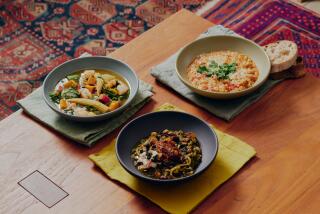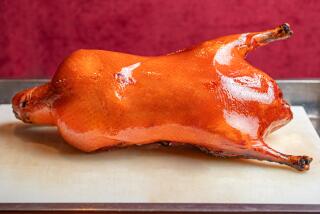The worldly pumpkin
- Share via
THREE times lately I have had to reassure friends that using canned pumpkin is not a crime against nature -- having seen the fruit go from field to can in a factory in Illinois, I know there is nothing to it but pure puree. But every time I go to a farmers market lately I hear the opposing argument in my head while looking over the gorgeous, fat, pie pumpkins and cheese pumpkins available fresh.
This time of year getting out a can opener really is a shame. The pumpkins glowing orange and taupe in the fall sunlight beg to be turned into anything but a dish where the canned kind would do. Add an Asian accent and the chunky orange flesh can be converted into an amazing entree, or appetizer, or side dish, no crust required.
What’s surprising is that pumpkin and the cuisines of countries associated more with sushi and curry are actually very old friends. Squash, the huge family that includes pumpkin, may have originated in the Americas, but it has traveled farther and wider than even corn. And cooks who use it halfway around the globe do things to it that Libby’s has never put on the label.
In South Korea, for instance, hardly the first country that comes to mind when you mention pumpkin, it is converted into a porridge with red beans that is finished with cinnamon-scented balls of rice. Hi Soo Shin Hepinstall, giving the recipe in her book “Growing Up in a Korean Kitchen,” writes that pumpkin was brought to her homeland by the Dutch in the late 1500s.
It also must have a long history on the Indian subcontinent, because it is absolutely ingrained in the cuisine there, whether stewed in curries or deep-fried as pakora. Japanese cookbooks do not often specify pumpkin, but that country harvests a cornucopia of excellent winter squash that will do as well or better in any recipe, particularly Hokkaido and kabocha.
The many virtues of fresh pumpkin include its ability to cross any geographic or culinary border, to be savory or sweet, dessert or main dish. As well as it works with cinnamon and cloves, it also takes to the assertiveness of Asian fish sauce or garlic-chile paste, and it is as complementary with fresh ginger as with ground. It may be a fruit, but it has vegetable muscle.
Right now two types of pumpkin are readily available, and both work extremely well in savory recipes. Pie pumpkins look like miniature jack-o’-lanterns, round and deep orange, while cheese pumpkins are taupe-colored and heavy and look like butternut squash turned into tuffets. (They are much smaller cousins of the pumpkins that wind up in cans.)
Asian influence
SLICED thin, either pumpkin cooks very fast for tempura. A light batter of egg yolk, rice flour and club soda insulates the meat from the hot oil just long enough for the sturdy flesh to caramelize and turn sweet.
All it needs is a dipping sauce of salty shoyu or tamari, sweet mirin, garlic-chile paste and lots of fresh ginger. You could serve this as an appetizer or add a few more complementary vegetables to the mix (sliced shiitakes, red peppers, broccoli) and make it a main dish.
The only tricks are that the oil has to be perfectly hot (375 degrees -- a candy thermometer is your best friend); the pumpkin has to be dusted in superfine rice flour to make the batter adhere; and the batter itself should be left fairly lumpy.
One of the more fascinating ways to cook pumpkin comes from Vietnam. Nicole Routhier included a braising recipe in her 1989 cookbook “The Foods of Vietnam.” A lavish amount of garlic along with a little sugar and good dose of fish sauce takes pumpkin into another realm of flavor, with sweetness against that haunting undertone from the fish sauce.
As someone who thinks everything goes better with curry, I am happiest turning a pumpkin into a main dish with duck, another favorite ingredient.
Knowing that Thai curries sometimes use pumpkin, I came up with a slow stew with shallots, ginger and coconut milk. Unlike Indian curries, which start with various freshly ground spices, this one is dependent on curry paste. The excellent kind that comes in a can.
*
Pumpkin tempura
Total time: About 1 hour
Servings: 4 to 6
3/8 cup shoyu or tamari
3/8 cup mirin
1 tablespoon minced fresh ginger
1 1/2 teaspoons Asian garlic-chile paste, or to taste
1 (2-pound) sugar pumpkin
1 large egg yolk
1 cup cold club soda or
seltzer
1 1/2 cups rice flour, divided
Peanut or canola oil for deep frying
1. In a small bowl, combine the shoyu or tamari with the mirin, ginger and garlic-chile paste and set aside. (Makes three-fourths cup dipping sauce.)
2. Cut the pumpkin in half and scrape out the seeds. Cut it in half again and remove the skin. Cut each quarter crosswise into half-moon slices about one-fourth-inch thick.
3. In a wok or skillet, heat the oil for deep frying to 375 degrees.
4. In a bowl, while the oil heats, combine the egg yolk and club soda. Add 1 cup of the flour and whisk lightly but not until smooth; it should be lumpy and airy. Place the remaining flour in a shallow bowl.
5. Working in batches, dredge the pumpkin slices first in the flour, shaking off the excess, then in the batter. (If the batter gets too thick, add a little more club soda and whisk lightly.) Lay the battered pumpkin into the hot oil without crowding. Cook, turning once, until the pieces are crisp outside and tender inside and caramelizing around the edges, about 3 minutes. Drain on paper towels and serve warm with the dipping sauce.
Each of 6 servings: 355 calories; 6 grams protein; 47 grams carbohydrates; 3 grams fiber; 15 grams fat; 3 grams saturated fat; 34 mg. cholesterol; 1,072 mg. sodium.
*
Vietnamese glazed pumpkin
Total time: 1 hour
Servings: 4 to 6
Note: From “The Foods of Vietnam” by Nicole Routhier
1 (3-pound) cheese or pie pumpkin
1 tablespoon peanut oil
6 cloves garlic, minced
1/2 cup chicken stock
1 tablespoon Vietnamese fish sauce
2 tablespoons sugar
Freshly ground black
pepper
Steamed rice (optional)
1. Peel and seed the pumpkin. Cut the flesh into 1-inch cubes.
2. In a large skillet, heat the oil over moderate heat. Add the garlic and fry for a few seconds without browning. Add the pumpkin and fry 1 minute, shaking to coat the cubes with oil. Add the stock, fish sauce and sugar and mix well. Bring to a rapid boil. Cover the pan, reduce the heat to low and simmer 20 to 25 minutes, until the pumpkin is tender but not mushy and the sauce is reduced to about 2 tablespoons. If there is still too much liquid in the pan, raise the heat and boil uncovered to reduce it to a glaze.
3. Sprinkle the pumpkin with black pepper to taste and serve at once, over rice if you like.
Each of 6 servings: 100 calories; 2 grams protein; 19 grams carbohydrates; 2 grams fiber; 3 grams fat; 0 saturated fat; 0 cholesterol; 245 mg. sodium.
*
Thai red curry duck with pumpkin
Total time: About 2 hours
Servings: 4
1 tablespoon peanut or
vegetable oil
2 cloves garlic, minced
1 tablespoon grated fresh ginger
4 shallots, thinly sliced
3 cups coconut milk
2 to 3 teaspoons Thai red curry paste
4 duck legs, skin and fat removed
Salt
1 (2-pound) sugar or cheese pumpkin, seeded, peeled and cut into 1-inch cubes
1 tablespoon freshly squeezed lime juice
2 tablespoons julienned Thai basil (or chopped
cilantro)
Cooked rice, such as jasmine or a short-grain rice
1. In a deep heavy skillet or Dutch oven, heat the oil. Add the garlic, ginger and shallots and saute until softened, about 5 minutes. Stir in the coconut milk and 2 teaspoons of the curry paste. Season the duck legs well with three-fourths teaspoon salt and add to the pan. Bring to a simmer, cover the pan and cook until the duck is very tender, about 45 minutes to 1 hour.
2. Using a slotted spoon, transfer the duck legs to a plate and let stand until cool enough to handle.
3. Add the diced pumpkin to the pan and return to a simmer. Cook, covered, until the pumpkin is soft but not mushy, about 45 minutes.
4. Shred the duck meat into bite-size chunks and return it to the pan. Cook, stirring occasionally, until the meat is heated through. Stir in the lime juice. Taste and add more curry paste or salt if needed. Sprinkle with the basil and serve with rice.
Each serving: 582 calories; 27 grams protein; 22 grams carbohydrates; 5 grams fiber; 46 grams fat; 34 grams saturated fat; 79 mg. cholesterol; 112 mg. sodium.


